weight KIA RIO HATCHBACK 2019 Owners Manual
[x] Cancel search | Manufacturer: KIA, Model Year: 2019, Model line: RIO HATCHBACK, Model: KIA RIO HATCHBACK 2019Pages: 503, PDF Size: 10.42 MB
Page 7 of 503
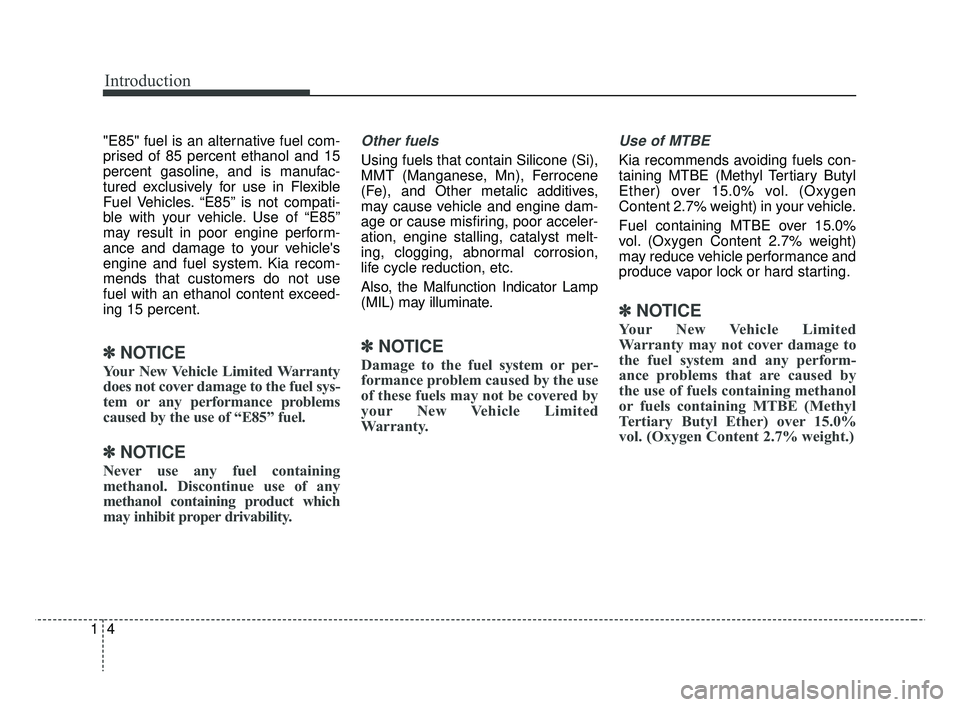
Introduction
41
"E85" fuel is an alternative fuel com-
prised of 85 percent ethanol and 15
percent gasoline, and is manufac-
tured exclusively for use in Flexible
Fuel Vehicles. “E85” is not compati-
ble with your vehicle. Use of “E85”
may result in poor engine perform-
ance and damage to your vehicle's
engine and fuel system. Kia recom-
mends that customers do not use
fuel with an ethanol content exceed-
ing 15 percent.
✽ ✽
NOTICE
Your New Vehicle Limited Warranty
does not cover damage to the fuel sys-
tem or any performance problems
caused by the use of “E85” fuel.
✽ ✽
NOTICE
Never use any fuel containing
methanol. Discontinue use of any
methanol containing product which
may inhibit proper drivability.
Other fuels
Using fuels that contain Silicone (Si),
MMT (Manganese, Mn), Ferrocene
(Fe), and Other metalic additives,
may cause vehicle and engine dam-
age or cause misfiring, poor acceler-
ation, engine stalling, catalyst melt-
ing, clogging, abnormal corrosion,
life cycle reduction, etc.
Also, the Malfunction Indicator Lamp
(MIL) may illuminate.
✽ ✽
NOTICE
Damage to the fuel system or per-
formance problem caused by the use
of these fuels may not be covered by
your New Vehicle Limited
Warranty.
Use of MTBE
Kia recommends avoiding fuels con-
taining MTBE (Methyl Tertiary Butyl
Ether) over 15.0% vol. (Oxygen
Content 2.7% weight) in your vehicle.
Fuel containing MTBE over 15.0%
vol. (Oxygen Content 2.7% weight)
may reduce vehicle performance and
produce vapor lock or hard starting.
✽ ✽
NOTICE
Your New Vehicle Limited
Warranty may not cover damage to
the fuel system and any perform-
ance problems that are caused by
the use of fuels containing methanol
or fuels containing MTBE (Methyl
Tertiary Butyl Ether) over 15.0%
vol. (Oxygen Content 2.7% weight.)
SC CAN (ENG) 1.QXP 7/18/2018 5:30 PM Page 4
Page 22 of 503

35
Safety features of your vehicle
Front seat adjustment
Forward and backward
To move the seat forward or backward:
1. Pull the seat slide adjustmentlever up and hold it.
2. Slide the seat to the position you desire.
3. Release the lever and make sure the seat is locked in place.
Adjust the seat before driving, and
make sure the seat is locked securely
by trying to move forward and back-
ward without using the lever. If the
seat moves, it is not locked properly.
Seatback angle
To recline the seatback:
1. Lean forward slightly and lift up the seatback recline lever.
2. Carefully lean back on the seat and adjust the seatback of the
seat to the position you desire.
3. Release the lever and make sure the seatback is locked in place.
(The lever MUST return to its orig-
inal position for the seatback to
lock.)OYB036003
WARNING- Unexpected
seat movement
After adjusting a manual seat,
always check that it is locked by
shifting your weight to the front
and back. Sudden or unexpect-
ed movement of the driver's
seat could cause you to lose
control of the vehicle.
OYB036004
SC CAN (ENG) 3.QXP 7/18/2018 5:54 PM Page 5
Page 43 of 503
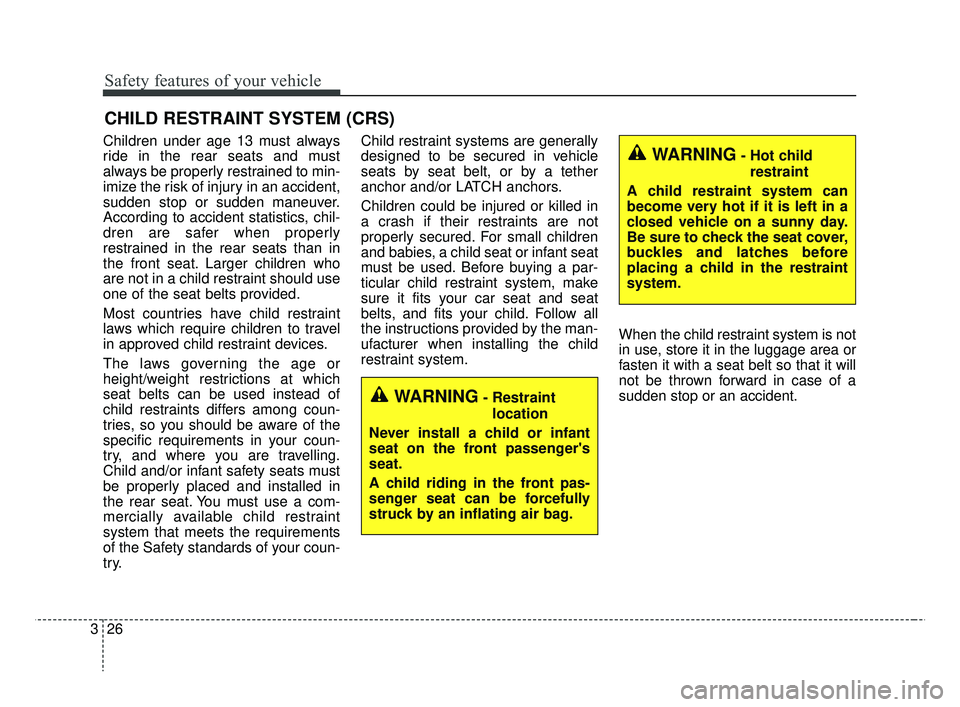
Safety features of your vehicle
26
3
CHILD RESTRAINT SYSTEM (CRS)
Children under age 13 must always
ride in the rear seats and must
always be properly restrained to min-
imize the risk of injury in an accident,
sudden stop or sudden maneuver.
According to accident statistics, chil-
dren are safer when properly
restrained in the rear seats than in
the front seat. Larger children who
are not in a child restraint should use
one of the seat belts provided.
Most countries have child restraint
laws which require children to travel
in approved child restraint devices.
The laws governing the age or
height/weight restrictions at which
seat belts can be used instead of
child restraints differs among coun-
tries, so you should be aware of the
specific requirements in your coun-
try, and where you are travelling.
Child and/or infant safety seats must
be properly placed and installed in
the rear seat. You must use a com-
mercially available child restraint
system that meets the requirements
of the Safety standards of your coun-
try. Child restraint systems are generally
designed to be secured in vehicle
seats by seat belt, or by a tether
anchor and/or LATCH anchors.
Children could be injured or killed in
a crash if their restraints are not
properly secured. For small children
and babies, a child seat or infant seat
must be used. Before buying a par-
ticular child restraint system, make
sure it fits your car seat and seat
belts, and fits your child. Follow all
the instructions provided by the man-
ufacturer when installing the child
restraint system.
When the child restraint system is not
in use, store it in the luggage area or
fasten it with a seat belt so that it will
not be thrown forward in case of a
sudden stop or an accident.
WARNING- Restraint
location
Never install a child or infant
seat on the front passenger's
seat.
A child riding in the front pas-
senger seat can be forcefully
struck by an inflating air bag.
WARNING- Hot child restraint
A child restraint system can
become very hot if it is left in a
closed vehicle on a sunny day.
Be sure to check the seat cover,
buckles and latches before
placing a child in the restraint
system.
SC CAN (ENG) 3.QXP 7/18/2018 5:56 PM Page 26
Page 44 of 503
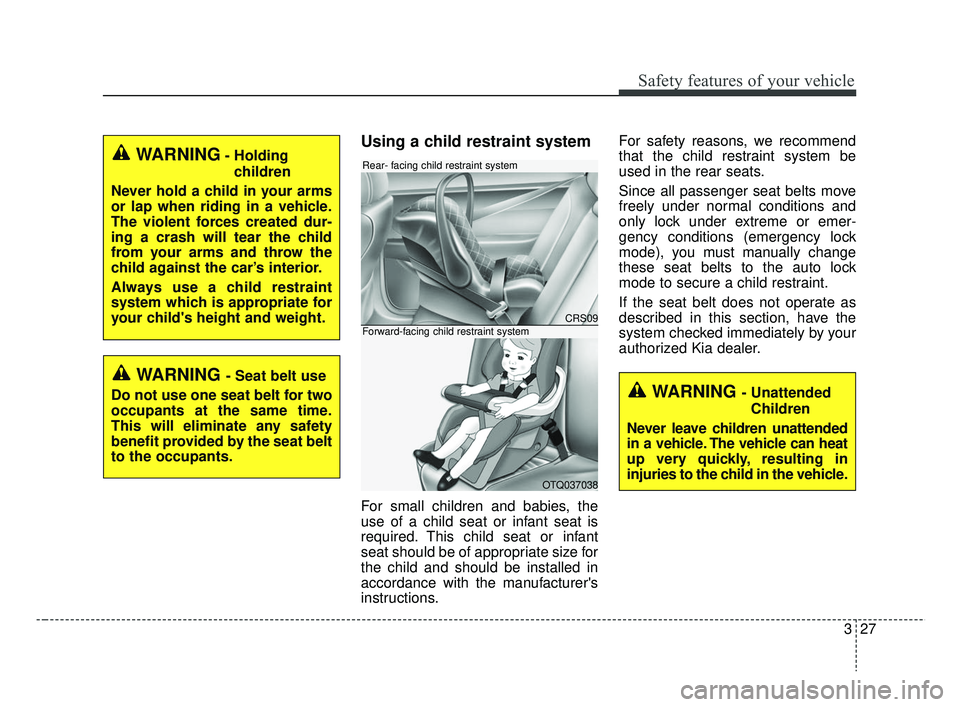
327
Safety features of your vehicle
Using a child restraint system
For small children and babies, the
use of a child seat or infant seat is
required. This child seat or infant
seat should be of appropriate size for
the child and should be installed in
accordance with the manufacturer's
instructions.For safety reasons, we recommend
that the child restraint system be
used in the rear seats.
Since all passenger seat belts move
freely under normal conditions and
only lock under extreme or emer-
gency conditions (emergency lock
mode), you must manually change
these seat belts to the auto lock
mode to secure a child restraint.
If the seat belt does not operate as
described in this section, have the
system checked immediately by your
authorized Kia dealer.
WARNING- Holding
children
Never hold a child in your arms
or lap when riding in a vehicle.
The violent forces created dur-
ing a crash will tear the child
from your arms and throw the
child against the car’s interior.
Always use a child restraint
system which is appropriate for
your child's height and weight.
WARNING - Seat belt use
Do not use one seat belt for two
occupants at the same time.
This will eliminate any safety
benefit provided by the seat belt
to the occupants.
CRS09
OTQ037038
Rear- facing child restraint system
Forward-facing child restraint system
WARNING - Unattended Children
Never leave children unattended
in a vehicle. The vehicle can heat
up very quickly, resulting in
injuries to the child in the vehicle.
SC CAN (ENG) 3.QXP 7/18/2018 5:56 PM Page 27
Page 58 of 503

341
Safety features of your vehicle
Main components of occupantdetection system
A detection device located within the front passenger seat cushion.
An electronic system which deter- mines whether the passenger air
bag systems should be activated
or deactivated.
An indicator light located on the instrument panel which illuminates
the words PASSENGER AIR BAG
“OFF” indicating the front passen-
ger air bag system is deactivated.
The instrument panel air bag warn- ing light is interconnected with the
occupant detection system. If the front passenger seat is occupied
by a person that the system deter-
mines to be of adult size, and he/she
sits properly (sitting upright with the
seatback in an upright position, cen-
tered on the seat cushion with their
seat belt on, legs comfortably extend-
ed and their feet on the floor), the
PASSENGER AIR BAG “OFF” indica-
tor will turn off and the front passen-
ger's air bag will be able to inflate, if
necessary, in frontal crashes.
You will find the PASSENGER AIR
BAG “OFF” indicator on the center facia
panel. This system detects the condi-
tions 1~4 in the following table and acti-
vates or deactivates the front passen-
ger air bag based on these conditions.
Always be sure that you and all vehicle
occupants are seated and restrained
properly (sitting upright with the seat in
an upright position, centered on the
seat cushion, with the person’s legs
comfortably extended, feet on the
floor, and wearing the safety belt prop-
erly) for the most effective protection
by the air bag and the safety belt. The ODS (Occupant Detection
System) may not function properly if
the passenger takes actions which
can defeat the detection system.
These include:
(1) Failing to sit in an upright position.
(2) Leaning against the door or cen- ter console.
(3) Sitting towards the sides or the front of the seat.
(4) Putting legs on the dashboard or resting them on other locations
which reduce the passenger
weight on the front seat.
(5) Improperly wearing the safety belt.
(6) Reclining the seat back.
SC CAN (ENG) 3.QXP 7/18/2018 5:56 PM Page 41
Page 220 of 503
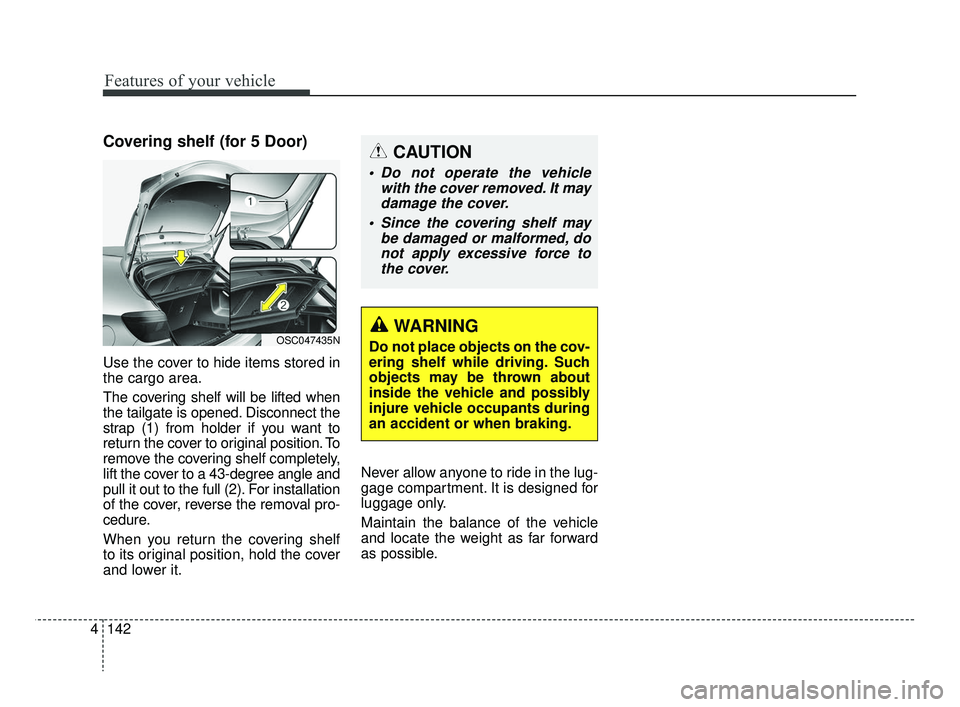
Features of your vehicle
142
4
Covering shelf (for 5 Door)
Use the cover to hide items stored in
the cargo area.
The covering shelf will be lifted when
the tailgate is opened. Disconnect the
strap (1) from holder if you want to
return the cover to original position. To
remove the covering shelf completely,
lift the cover to a 43-degree angle and
pull it out to the full (2). For installation
of the cover, reverse the removal pro-
cedure.
When you return the covering shelf
to its original position, hold the cover
and lower it. Never allow anyone to ride in the lug-
gage compartment. It is designed for
luggage only.
Maintain the balance of the vehicle
and locate the weight as far forward
as possible.
OSC047435NWARNING
Do not place objects on the cov-
ering shelf while driving. Such
objects may be thrown about
inside the vehicle and possibly
injure vehicle occupants during
an accident or when braking.
CAUTION
Do not operate the vehicle
with the cover removed. It maydamage the cover.
Since the covering shelf may be damaged or malformed, donot apply excessive force tothe cover.
SC CAN (ENG) 4.QXP 7/18/2018 5:53 PM Page 142
Page 264 of 503
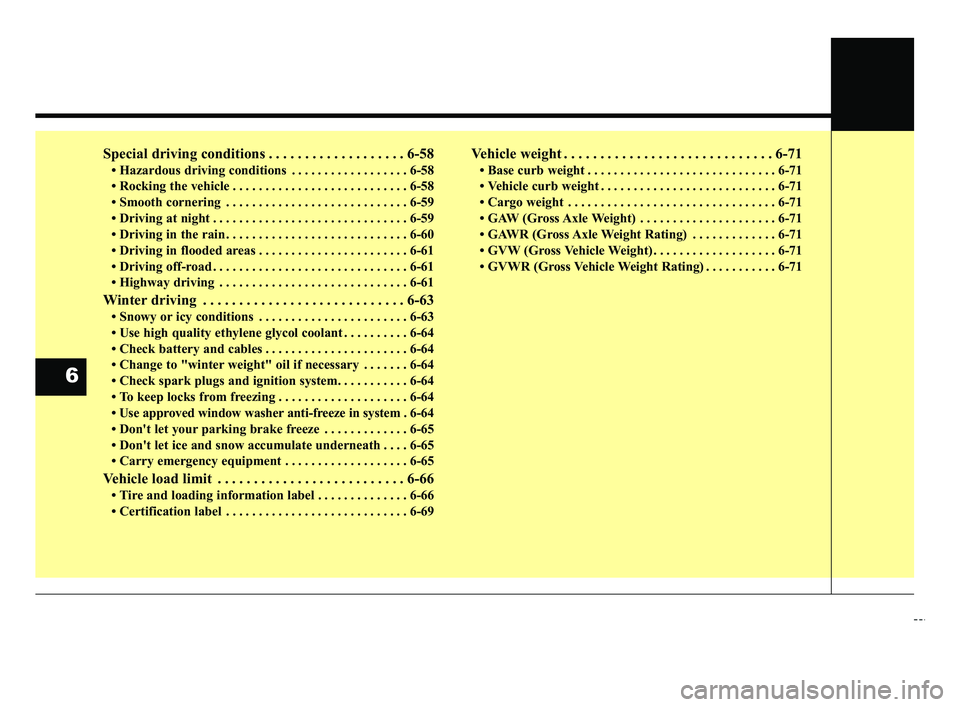
6
Special driving conditions . . . . . . . . . . . . . . . . . . . 6-58
• Hazardous driving conditions . . . . . . . . . . . . . . . . . . 6-58
• Rocking the vehicle . . . . . . . . . . . . . . . . . . . . . . . . . . . 6-58
• Smooth cornering . . . . . . . . . . . . . . . . . . . . . . . . . . . . 6-59
• Driving at night . . . . . . . . . . . . . . . . . . . . . . . . . . . . . . 6-59
• Driving in the rain . . . . . . . . . . . . . . . . . . . . . . . . . . . . 6-60
• Driving in flooded areas . . . . . . . . . . . . . . . . . . . . . . . 6-61
• Driving off-road . . . . . . . . . . . . . . . . . . . . . . . . . . . . . . 6-61
• Highway driving . . . . . . . . . . . . . . . . . . . . . . . . . . . . . 6-61
Winter driving . . . . . . . . . . . . . . . . . . . . . . . . . . . . 6-63
• Snowy or icy conditions . . . . . . . . . . . . . . . . . . . . . . . 6-63
• Use high quality ethylene glycol coolant . . . . . . . . . . 6-64
• Check battery and cables . . . . . . . . . . . . . . . . . . . . . . 6-64
• Change to "winter weight" oil if necessary . . . . . . . 6-64
• Check spark plugs and ignition system. . . . . . . . . . . 6-64
• To keep locks from freezing . . . . . . . . . . . . . . . . . . . . 6-64
• Use approved window washer anti-freeze in system . 6-64
• Don't let your parking brake freeze . . . . . . . . . . . . . 6-65
• Don't let ice and snow accumulate underneath . . . . 6-65
• Carry emergency equipment . . . . . . . . . . . . . . . . . . . 6-65
Vehicle load limit . . . . . . . . . . . . . . . . . . . . . . . . . . 6-66
• Tire and loading information label . . . . . . . . . . . . . . 6-66
• Certification label . . . . . . . . . . . . . . . . . . . . . . . . . . . . 6-69
Vehicle weight . . . . . . . . . . . . . . . . . . . . . . . . . . . . . 6-71
• Base curb weight . . . . . . . . . . . . . . . . . . . . . . . . . . . . . 6-71
• Vehicle curb weight . . . . . . . . . . . . . . . . . . . . . . . . . . . 6-71
• Cargo weight . . . . . . . . . . . . . . . . . . . . . . . . . . . . . . . . 6-71
• GAW (Gross Axle Weight) . . . . . . . . . . . . . . . . . . . . . 6-71
• GAWR (Gross Axle Weight Rating) . . . . . . . . . . . . . 6-71
• GVW (Gross Vehicle Weight) . . . . . . . . . . . . . . . . . . . 6-71
• GVWR (Gross Vehicle Weight Rating) . . . . . . . . . . . 6-71
SC CAN (ENG) 6.QXP 7/18/2018 5:41 PM Page 2
Page 285 of 503
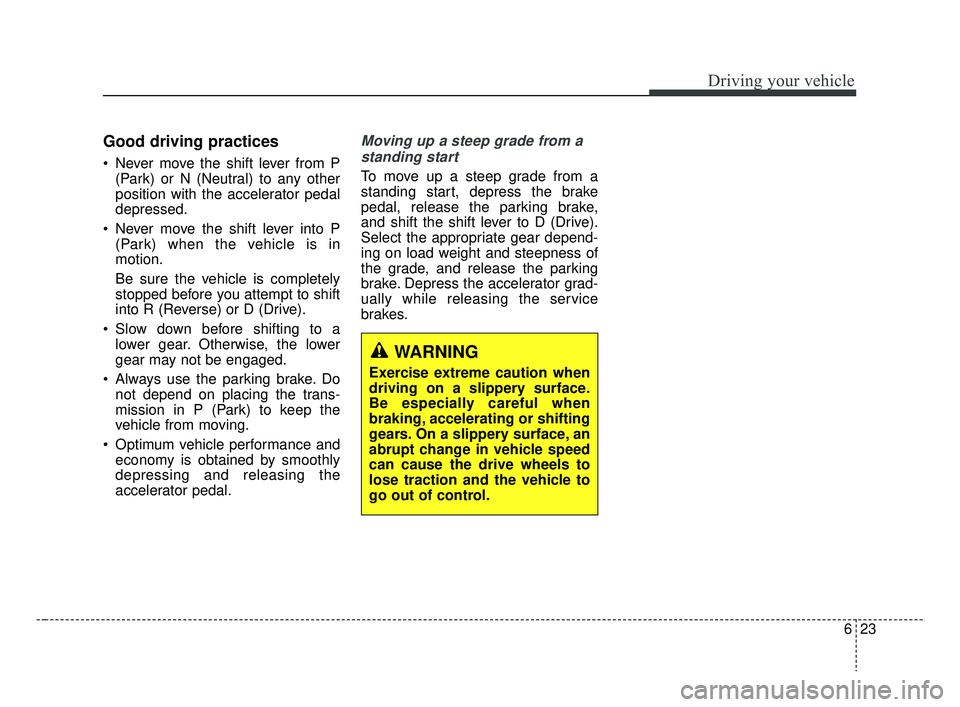
623
Driving your vehicle
Good driving practices
Never move the shift lever from P(Park) or N (Neutral) to any other
position with the accelerator pedal
depressed.
Never move the shift lever into P (Park) when the vehicle is in
motion.
Be sure the vehicle is completely
stopped before you attempt to shift
into R (Reverse) or D (Drive).
Slow down before shifting to a lower gear. Otherwise, the lower
gear may not be engaged.
Always use the parking brake. Do not depend on placing the trans-
mission in P (Park) to keep the
vehicle from moving.
Optimum vehicle performance and economy is obtained by smoothly
depressing and releasing the
accelerator pedal.
Moving up a steep grade from a
standing start
To move up a steep grade from a
standing start, depress the brake
pedal, release the parking brake,
and shift the shift lever to D (Drive).
Select the appropriate gear depend-
ing on load weight and steepness of
the grade, and release the parking
brake. Depress the accelerator grad-
ually while releasing the service
brakes.
WARNING
Exercise extreme caution when
driving on a slippery surface.
Be especially careful when
braking, accelerating or shifting
gears. On a slippery surface, an
abrupt change in vehicle speed
can cause the drive wheels to
lose traction and the vehicle to
go out of control.
SC CAN (ENG) 6.QXP 7/18/2018 5:41 PM Page 23
Page 318 of 503
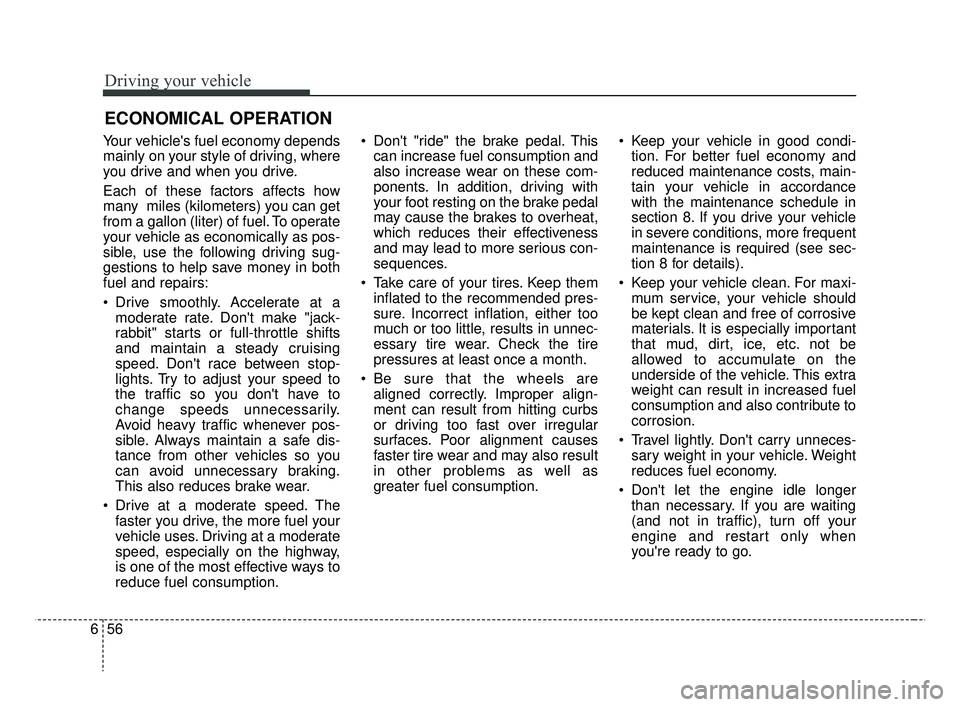
Driving your vehicle
56
6
Your vehicle's fuel economy depends
mainly on your style of driving, where
you drive and when you drive.
Each of these factors affects how
many miles (kilometers) you can get
from a gallon (liter) of fuel. To operate
your vehicle as economically as pos-
sible, use the following driving sug-
gestions to help save money in both
fuel and repairs:
Drive smoothly. Accelerate at a
moderate rate. Don't make "jack-
rabbit" starts or full-throttle shifts
and maintain a steady cruising
speed. Don't race between stop-
lights. Try to adjust your speed to
the traffic so you don't have to
change speeds unnecessarily.
Avoid heavy traffic whenever pos-
sible. Always maintain a safe dis-
tance from other vehicles so you
can avoid unnecessary braking.
This also reduces brake wear.
Drive at a moderate speed. The faster you drive, the more fuel your
vehicle uses. Driving at a moderate
speed, especially on the highway,
is one of the most effective ways to
reduce fuel consumption. Don't "ride" the brake pedal. This
can increase fuel consumption and
also increase wear on these com-
ponents. In addition, driving with
your foot resting on the brake pedal
may cause the brakes to overheat,
which reduces their effectiveness
and may lead to more serious con-
sequences.
Take care of your tires. Keep them inflated to the recommended pres-
sure. Incorrect inflation, either too
much or too little, results in unnec-
essary tire wear. Check the tire
pressures at least once a month.
Be sure that the wheels are aligned correctly. Improper align-
ment can result from hitting curbs
or driving too fast over irregular
surfaces. Poor alignment causes
faster tire wear and may also result
in other problems as well as
greater fuel consumption. Keep your vehicle in good condi-
tion. For better fuel economy and
reduced maintenance costs, main-
tain your vehicle in accordance
with the maintenance schedule in
section 8. If you drive your vehicle
in severe conditions, more frequent
maintenance is required (see sec-
tion 8 for details).
Keep your vehicle clean. For maxi- mum service, your vehicle should
be kept clean and free of corrosive
materials. It is especially important
that mud, dirt, ice, etc. not be
allowed to accumulate on the
underside of the vehicle. This extra
weight can result in increased fuel
consumption and also contribute to
corrosion.
Travel lightly. Don't carry unneces- sary weight in your vehicle. Weight
reduces fuel economy.
Don't let the engine idle longer than necessary. If you are waiting
(and not in traffic), turn off your
engine and restart only when
you're ready to go.
ECONOMICAL OPERATION
SC CAN (ENG) 6.QXP 7/18/2018 5:43 PM Page 56
Page 326 of 503

Driving your vehicle
64
6
Use high quality ethylene gly-
col coolant
Your vehicle is delivered with high
quality ethylene glycol coolant in the
cooling system. It is the only type of
coolant that should be used because
it helps prevent corrosion in the cool-
ing system, lubricates the water
pump and prevents freezing. Be sure
to replace or replenish your coolant
in accordance with the maintenance
schedule in section 8. Before winter,
have your coolant tested to assure
that its freezing point is sufficient for
the temperatures anticipated during
the winter.
Check battery and cables
Winter puts additional burdens on
the battery system. Visually inspect
the battery and cables as described
in section 8. The level of charge in
your battery can be checked by an
authorized Kia dealer or a service
station.
Change to "winter weight" oil
if necessary
In some climates it is recommended
that a lower viscosity "winter weight"
oil be used during cold weather. See
section 9 for recommendations. If
you aren't sure what weight oil you
should use, consult an authorized
Kia dealer.
Check spark plugs and igni-
tion system
Inspect your spark plugs as
described in section 8 and replace
them if necessary. Also check all
ignition wiring and components to be
sure they are not cracked, worn or
damaged in any way.
To keep locks from freezing
To keep the locks from freezing,
squirt an approved de-icer fluid or
glycerine into the key opening. If a
lock is covered with ice, squirt it with
an approved de-icing fluid to remove
the ice. If the lock is frozen internally,
you may be able to thaw it out by
using a heated key. Handle the heat-
ed key with care to avoid injury.
Use approved window washer
anti-freeze in system
To keep the water in the window
washer system from freezing, add an
approved window washer anti-freeze
solution in accordance with instruc-
tions on the container. Window wash-
er anti-freeze is available from an
authorized Kia dealer and most auto
parts outlets. Do not use engine
coolant or other types of anti-freeze
as these may damage the paint fin-
ish.
SC CAN (ENG) 6.QXP 7/18/2018 5:43 PM Page 64